It must be the best part of two decades since I first gazed at photos of John Wilson et al posing with huge catfish they’d caught from the Ebro. I’ve wanted to fish there ever since, but had been put off because in many popular areas such as Mequinenza and Caspe, the “fishing” has evolved into nothing more than sitting back as your rods are positioned for you by someone in a rowing boat and your hair-rigged pellet hookbait tipped over the side with several kilos of loose pellets.
When a bite materialises there is little more to do than winch in an overfed, pellet-addicted lump of a catfish. This is a far cry from the traditional tactics employed on the Ebro such as clonking and boat fishing with a float or lure and this is what fishing on the Ebro is all about to me – putting in the effort yourself whilst drawing upon the experience of a good guide – and I‘ve always felt the river could offer me more.
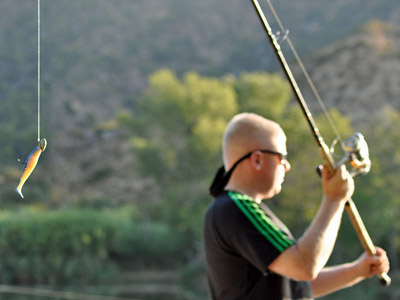 Despite this watering-down of methods there are still alternatives available if you can find the right guides in the right areas. A chance conversation with Will Barnard a couple of years ago reminded me of a trip he and Welchy had been on.
Despite this watering-down of methods there are still alternatives available if you can find the right guides in the right areas. A chance conversation with Will Barnard a couple of years ago reminded me of a trip he and Welchy had been on.
Will spoke very highly of the outfit they‘d gone with – Rio Ebro Angling, run by Carl and Angie Allman – and crucially they‘d done a fair bit of boat fishing with lures. (A fair bit indeed; I jigged a bit of rubber over the same patch of river non-stop from dawn to dusk for three incredibly happy – and successful – days – Ed)
In February this year, I got a phone call from Shane Calton. He was visiting the Ebro in September with his mate Dave Newby-Thornley and they were looking for a third person to make up the group. Shane was keen to catch cats, carp and whatever else was on offer whilst Dave, an avid roach and bream angler, had heard of the Ebro’s big roach potential. I remember laughing on the phone because it was exactly the kind of Ebro trip I’d been waiting for!
We contacted a few companies to see if they could offer us the more traditional and mixed fishing we sought but Rio Ebro seemed to have more knowledge and experience with roach and zander as well as the cats and they soon emerged as our clear favourites and a booking was made!
After six months of the excitement building we flew out to Reus airport – 70 miles west of Barcelona – and were met by a friendly chap named Keith, who delivered us to the village of Riba Roja d‘Ebre, our base for the week. The accommodation was clean and comfortable with air conditioning and was handily located in the centre, close to a bar and amenities. The only downside was being opposite the church, which has the loudest bell I‘ve ever heard!
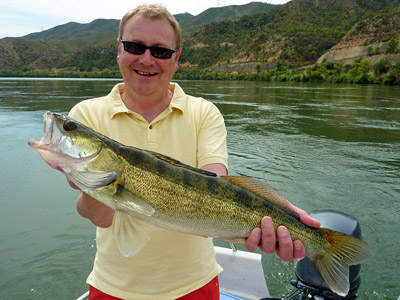 The landscape surrounding the river at Riba Roja is stark and intriguing. It’s reminiscent of a scene from a spaghetti western, with large, sparsely vegetated hills sloping quickly down to the Ebro, which is flanked – surprisingly – by bamboo. I half-expected to see the entrance to a goldmine heading into the hills!
The landscape surrounding the river at Riba Roja is stark and intriguing. It’s reminiscent of a scene from a spaghetti western, with large, sparsely vegetated hills sloping quickly down to the Ebro, which is flanked – surprisingly – by bamboo. I half-expected to see the entrance to a goldmine heading into the hills!
Anyway, onto the fishing! I’ve split this feature into two; the second part will cover the catfish and this one everything else.
The first species we targeted was zander. After breakfast on the first morning, we headed up towards the hydroelectric dam with a stash of bleak, which we saw shoals of all over the river. We lip-hooked these on a size 1/0 treble attached to two feet of 60lb mono, above which was a sliding 2.5 ounce lead.
First we anchored in the flow and bottom-bounced the rigs downstream in the current, seeking out the gullies and troughs carved out by the dam outfall. This method was predominantly aimed at zander, but with catfish in the vicinity there was always a chance of hooking one, hence the heavy mono leader.
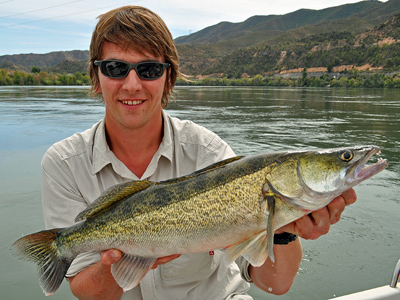 Dave had the first fish which was a reasonable zander. He’d never caught or even seen one before, so Carl quickly showed him how to hold a zed safely and the fish was returned after modest Dave reluctantly posed for a few photos.
Dave had the first fish which was a reasonable zander. He’d never caught or even seen one before, so Carl quickly showed him how to hold a zed safely and the fish was returned after modest Dave reluctantly posed for a few photos.
About ten minutes later I felt a couple of gentle shudders, followed by a sharp pull. The initial fight was strong, but then the fish rose to the surface quickly, in typical zander fashion. After a couple of headshakes, Carl had it in the boat and unhooked. It weighed about 6lb and was hooked cleanly in the scissors. The swim went dead after that so we moved as close to the dam wall as Carl dared take us. I couldn’t buy a bite, but Dave had a fish hit hard and the resulting strike met with something pulling harder than a zander.
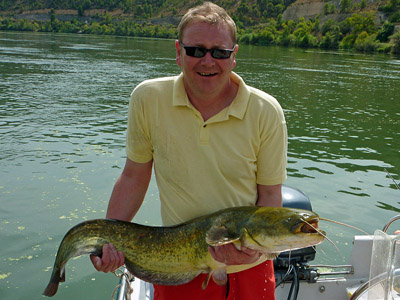 The scrap had Dave bewildered by its power, due to his previous experience with bream and roach, but his crash-course in playing a specimen resulted in our first catfish! It weighed around 25lb and was another first for Dave.
The scrap had Dave bewildered by its power, due to his previous experience with bream and roach, but his crash-course in playing a specimen resulted in our first catfish! It weighed around 25lb and was another first for Dave.
The following afternoon, after trolling lures for catfish, we decided it was worth another go for some zander and motored up towards the dam and switched to jigs & shads, which we fished between the weedbeds as we drifted in the current; to no avail.
Again, a catfish could have struck a jig at any time and Carl has seen plenty of monster cats hooked, with a fetish for the little rubbers. We moved nearer to the dam and experimented with different coloured shads. Out of the hundreds I’d taken with me I ended up using a pearlescent bleak imitation, complete with blue-coloured back. This worked almost instantly and when I flicked the lure up off the bottom it was grabbed by a decent zander before it could sink back down.
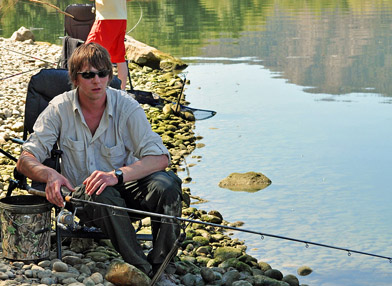 After this fish the action slowed; we were all tired from the sun, which had relentlessly beat down on us for the past two days, so we headed back to shore in time to visit the tackle shop at nearby Flix to pick up some groundbait and maggots for roach, carp and barbel fishing the next day.
After this fish the action slowed; we were all tired from the sun, which had relentlessly beat down on us for the past two days, so we headed back to shore in time to visit the tackle shop at nearby Flix to pick up some groundbait and maggots for roach, carp and barbel fishing the next day.
We arrived at our roach swims above the dam and mixed up our groundbait, which was a combination of a fine, dark crumb and a curious lemon-scented bait, which had the appearance of washing powder and soap flakes! We set up standard quiver tip rods with 6lb mono main line through to 3lb Maxima hook lengths and size 14 hooks. No finesse required here, even for fish which could far exceed the British record.
The small open-end feeders were set up on loop rigs and we made a few casts to get some groundbait into the swims before tying on our hooks. Being above the dam the river was really wide and, despite fishing at close range, we were casting into 12 metres of water! I clipped up at about 40 yards range and made a dozen casts to lay down a decent bed of bait.
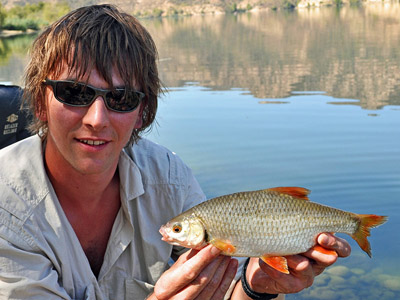
We had a sandwich while the groundbait settled then the baited hooks went out and we set about staring at the tips. Dave soon showed his silver fish pedigree by landing the first roach, which was a quality fish of about 12oz and this set the standard for the average size of roach we would catch.
I struck into my first bite of the day and felt a welcome ‘thud-thud-thud’ in return. This fish was a good 10 to 12oz and after this I was getting a bite every cast but for ten frustrating minutes I couldn’t hit any and every cast I reeled in either a bare hook or shrivelled maggot skins. We had no imitation maggots with us (a definite ‘must-pack’ item for any future trips) so I improvised to try and get the fish to take the hook as well as the bait. I threaded the hook inside the first maggot and slid it up the shank, ‘mag-aligner’ style, then conventionally hooked another two maggots to tip it off. This worked instantly and I landed two fish in my next two casts with it.
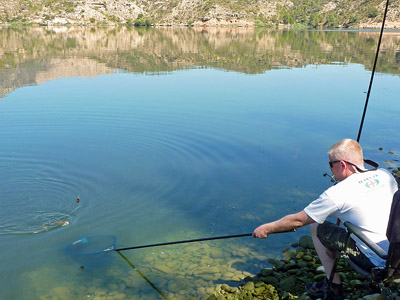
Shane was having a hard time, he had the only peg with no shade and was getting frustrated by a lack of bites so he moved up a few pegs to the other side of me where he landed a tiny sunfish, so he tweaked his rig by shortening the feeder loop and hooklength. On his very next cast his experimentation was rewarded and he latched into a huge fish, far bigger than anything we’d hooked and – as it turned out – bigger than any roach I’d ever seen.
He could tell immediately that this was a serious roach, so I headed over with the camera to get some shots of the battle. In doing so I caught a glimpse of a massive silver flash as the fish turned about eight feet down, my jaw dropped and it was a massive relief to see the fish finally slide over the net. The pristine, plump, 100% true roach weighed 2lb 5oz, which set him a new PB and it was a pleasure to see a roach of this size in the flesh; if only they were more common back home.
We each caught more roach but nothing came close to the size of this fish. I caught a couple over 1lb in a bag of over 20 fish and between us we caught around 50 roach, with nothing smaller than 6oz, plus a couple of sunfish. This was roach fishing at its best! It was a truly enjoyable day for all of us and I think many British anglers who travel to Ireland to target roach could happily exchange a week fishing there to instead chase the big silvers of the Ebro. I think they’d find it just as enjoyable and end up with a better tan to boot!
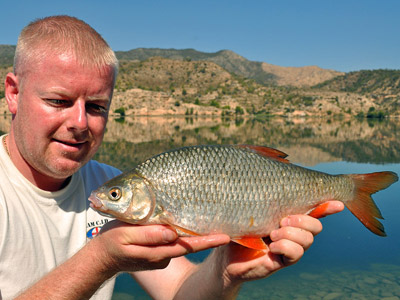
The last of the ‘alternative’ species we targeted was carp, though these are almost as popular as the catfish and specimens are regularly caught throughout the river. Most anglers opt to use scaled-down cat gear and bank fish with pellets in the hope of picking up both carp and cats. But if you yearn for something a little more involving and unique, there are alternative methods for targeting carp on the Ebro and we sampled some of these, albeit unsuccessfully.
All week we had pre-baited with maize in a lovely slack behind an island, to attract the carp without also drawing in catfish. We’d previously spotted a few carp including one very large common which was easily 30lb plus. On the final morning we could resist no longer so we made an early start and nestled the boat up against a large reedbed beside the 3 metre-deep, weedy hole.
We tackled up the lure rods with simple free-running lead rigs through to braided hooklengths and hair rigs, baited with single 12mm pellet baits so they stood out from the loosefeed. Despite sitting there silently for an hour and a half the only carp we saw were cruising rather than feeding and we left to do some more zander fishing once the sun was fully up.
Other species present in the middle Ebro include barbel, crucian carp and black bass, which all grow to good sizes but they can take some finding (though some guides offer opportunities to fish for them). So, whilst the big cats look likely to justifiably remain the key focus and draw for anglers heading to the Ebro, there is plenty to have a go at for those who crave something a little different.
I’ll be covering catfish in my next chronicle of the trip, so keep an eye out for that, coming soon…










